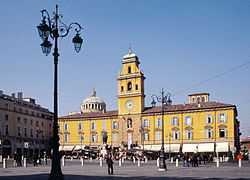Parma
| Parma | |||
|---|---|---|---|
| Comune | |||
| Comune di Parma | |||
|
Palazzo del Governatore, Parma | |||
| |||
 Parma Location of Parma in Italy | |||
| Coordinates: 44°48′N 10°20′E / 44.800°N 10.333°ECoordinates: 44°48′N 10°20′E / 44.800°N 10.333°E | |||
| Country | Italy | ||
| Region | Emilia-Romagna | ||
| Province | Parma (PR) | ||
| Frazioni | See list | ||
| Government | |||
| • Mayor | Federico Pizzarotti (M5S) | ||
| Area | |||
| • Total | 260.77 km2 (100.68 sq mi) | ||
| Elevation | 55 m (180 ft) | ||
| Population (28 February 2011) | |||
| • Total | 187,214 | ||
| • Density | 720/km2 (1,900/sq mi) | ||
| Demonym |
Parmigiani (Pram'zan) (Parmensi (Arijoz) are called the province's inhabitants) | ||
| Time zone | CET (UTC+1) | ||
| • Summer (DST) | CEST (UTC+2) | ||
| Postal code | 43121-43126 | ||
| Dialing code | 0521 | ||
| Patron saint | Sant'Ilario di Poitiers, Sant'Onorato, San Rocco | ||
| Saint day | January 13 | ||
| Website | Official website | ||
Parma ![]() listen (Emilian: Pärma) is a city in the Italian region of Emilia-Romagna famous for its prosciutto (ham), cheese, architecture, music and surrounding countryside. It is home to the University of Parma, one of the oldest universities in the world.
Parma is divided into two parts by the stream of the same name. The district on the far side of the river is Oltretorrente. Parma's Etruscan name was adapted by Romans to describe the round shield called Parma.
listen (Emilian: Pärma) is a city in the Italian region of Emilia-Romagna famous for its prosciutto (ham), cheese, architecture, music and surrounding countryside. It is home to the University of Parma, one of the oldest universities in the world.
Parma is divided into two parts by the stream of the same name. The district on the far side of the river is Oltretorrente. Parma's Etruscan name was adapted by Romans to describe the round shield called Parma.
The Italian poet Attilio Bertolucci (born in a hamlet in the countryside) wrote: "As a capital city it had to have a river. As a little capital it received a stream, which is often dry".
History
Prehistory
Parma was already a built-up area in the Bronze Age. It has now been verified that in the current position of the city rose a terramare. The "terramare" (marl earth) were ancient villages built of wood on piles according to a defined scheme and squared form; constructed on dry land and generally in proximity to the rivers. During this age (between 1500 BC and 800 BC) the first necropoleis (on the sites of the present-day Piazza Duomo and Piazzale della Macina) were constructed.
Antiquity
The city was most probably founded and named by the Etruscans, for a parma (circular shield) was a Latin borrowing, as were many Roman terms for particular arms, and Parmeal, Parmni and Parmnial are names that appear in Etruscan inscriptions. Diodorus Siculus (XXII, 2,2; XXVIII, 2,1) reported that the Romans had changed their rectangular shields for round ones, imitating the Etruscans. Whether the Etruscan encampment was so named because it was round, like a shield, or whether its situation was a shield against the Gauls to the north, is uncertain.
The Roman colony was founded in 183 BC, together with Mutina (Modena); 2,000 families were settled. Parma had a certain importance as a road hub over the Via Aemilia and the Via Claudia. It had a forum, in what is today the central Garibaldi Square. In 44 BC, the city was destroyed, and Augustus rebuilt it. During the Roman Empire, it gained the title of Julia for its loyalty to the imperial house.
The city was subsequently sacked by Attila, and later given by the Germanic king Odoacer to his followers. During the Gothic War, however, Totila destroyed it. It was then part of the Byzantine Exarchate of Ravenna (changing its name to Chrysopolis, "Golden City", probably due to the presence of the imperial treasury) and, from 569, of the Lombard Kingdom of Italy. During the Middle Ages, Parma became an important stage of the Via Francigena,[1] the main road connecting Rome to Northern Europe; several castles, hospitals and inns were built in the following centuries to host the increasing number of pilgrims who passed by Parma and Fidenza, following the Apennines via Collecchio, Berceto and the Corchia ranges before descending the Passo della Cisa into Tuscany, heading finally south toward Rome.
Middle Ages
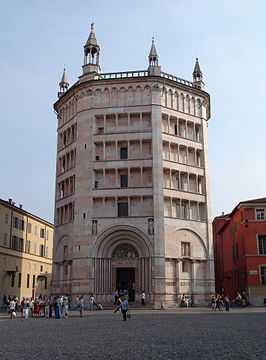
Under the Frankish rule, Parma became the capital of a county (774). Like most northern Italian cities, it was nominally a part of the Holy Roman Empire created by Charlemagne, but locally ruled by its bishops, the first being Guibodus. In the subsequent struggles between the Papacy and the Empire, Parma was usually a member of the Imperial party. Two of its bishops became antipopes: Càdalo, founder of the cathedral, as Honorius II; and Guibert, as Clement III. An almost independent commune was created around 1140; a treaty between Parma and Piacenza of 1149 is the earliest document of a comune headed by consuls.[2] After the Peace of Constance (1183) confirmed the Italian communes' rights of self-governance, long-standing quarrels with the neighbouring communes of Reggio Emilia, Piacenza and Cremona became harsher, with the aim of controlling the vital trading line over the Po River.
The struggle between Guelphs and Ghibellines was a feature of Parma too. In 1213, her podestà was the Guelph Rambertino Buvalelli. Then, after a long stance alongside the emperors, the Papist families of the city gained control in 1248. The city was besieged in 1247–48 by Emperor Frederick II, who was however crushed in the battle that ensued.
Modern era
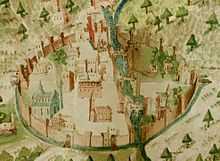
Parma fell under the control of Milan in 1341. After a short-lived period of independence under the Terzi family (1404–1409), the Sforza imposed their rule (1440–1449) through their associated families of Pallavicino, Rossi, Sanvitale and Da Correggio. These created a kind of new feudalism, building towers and castles throughout the city and the land. These fiefs evolved into truly independent states: the Landi governed the higher Taro's valley from 1257 to 1682. The Pallavicino seignory extended over the eastern part of today's province, with the capital in Busseto. Parma's territories were an exception for Northern Italy, as its feudal subdivision frequently continued until more recent years. For example, Solignano was a Pallavicino family possession until 1805, and San Secondo belonged to the Rossi well into the 19th century.
Between the 14th and the 15th centuries, Parma was at the centre of the Italian Wars. The Battle of Fornovo was fought in its territory. The French held the city in 1500–1521, with a short Papal parenthesis in 1512–1515. After the foreigners were expelled, Parma belonged to the Papal States until 1545.
In that year the Farnese pope, Paul III, detached Parma and Piacenza from the Papal States and gave them as a duchy to his illegitimate son, Pier Luigi Farnese, whose descendants ruled in Parma until 1731, when Antonio Farnese (1679–1731), last male of the Farnese line, died. In the Treaty of London (1718) it was promulgated that the heir to the duchy would be Elisabeth Farnese's elder son with Philip V of Spain, Don Carlos. In 1731, the fifteen-year-old Don Carlos became Charles I Duke of Parma and Piacenza, at the death of his childless great uncle Antonio Farnese. In 1734, Charles I conquered the kingdoms of Naples and Sicily, and was crowned as the King of Naples and Sicily on 3 July 1735, leaving the Duchy of Parma to his brother Philip (Filippo I di Borbone-Parma).
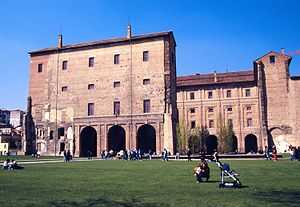
In 1594 a constitution was promulgated, the University enhanced and the Nobles' College founded. The war to reduce the barons' power continued for several years: in 1612 Barbara Sanseverino was executed in the central square of Parma, together with six other nobles charged of plotting against the duke. At the end of the 17th century, after the defeat of Pallavicini (1588) and Landi (1682) the Farnese duke could finally hold with firm hand all Parmense territories. The castle of the Sanseverino in Colorno was turned into a luxurious summer palace by Ferdinando Bibiena.
In 1731 the combined Duchy of Parma and Piacenza was given to the House of Bourbon in a diplomatic shuffle of the European dynastic politics that were played out in Italy. Under the new rulers, however, it faced a certain decadence. In 1734 all the outstanding art collections of the duke's palaces of Parma, Colorno and Sala Baganza were moved to Naples.
Parma was under French influence after the Peace of Aachen (1748). Parma became a modern state with the energetic action of prime minister Guillaume du Tillot. He created the bases for a modern industry and fought strenuously against the church's privileges. The city lived a period of particular splendour: the Biblioteca Palatina (Palatine Library), the Archaeological Museum, the Picture Gallery and the Botanical Garden were founded, together with the Royal Printing Works directed by Giambattista Bodoni, aided by the Amoretti Brothers as skilled and inspired punchcutters.
Contemporary age
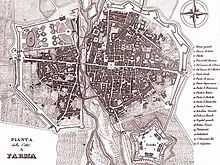
During the Napoleonic Wars (1802–1814), Parma was part of the Taro Département. Under its French name Parme, it was also created a duché grand-fief de l'Empire for Charles-François Lebrun, duc de Plaisance, the Emperor's Arch-Treasurer, on 24 April 1808 (extinguished 1926).
After its restoration by the 1814–15 Vienna Congress, the Risorgimento's upheavals had no fertile ground in the tranquil duchy. In 1847, after Marie Louise, Duchess of Parma's death, it passed again to the Bourbons, the last of whom was stabbed in the city and left it to his widow, Luisa Maria of Berry. On 15 September 1859 the dynasty was declared deposed, and Parma entered the newly formed province of Emilia under Luigi Carlo Farini. With the plebiscite of 1860 the former duchy became part of the unified Kingdom of Italy.
The loss of the capital role provoked an economic and social crisis in Parma. It started to recover its role of industrial prominence after the connection with Piacenza and Bologna of 1859, and with Fornovo and Suzzara in 1883. Trade unions were strong in the city, in which a famous General Strike was declared from 1 May to 6 June 1908. The struggle with Fascism had its most dramatic moment in the August 1922, when the regime officer Italo Balbo attempted to enter the popular quarter of Oltretorrente. The citizens organized into the Arditi del Popolo ("People's champions") and pushed back the squadristi. This episode is considered the first example of Resistance in Italy.
During World War II, Parma was a strong centre of partisan resistance. The train station and marshalling yards were targets for high altitude bombing by the Allies in the spring of 1944. Much of the Palazzo della Pilotta — situated not far (half a mile) from the train station — was destroyed. Along with it also Teatro Farnese and part of Biblioteca Palatina were destroyed by Allied bombs. Several other monuments were also damaged: Palazzo del Giardino, Steccata and San Giovanni churches, Palazzo Ducale, Paganini theater and the monument to Verdi. However Parma did not see widespread destruction during the war. Parma was liberated from the German occupation (1943–1945) on 26 April 1945 by the partisan resistance and troops of Brazilian Expeditionary Force.[3] Recently Parma was chosen for the setting of John Grisham's American football comedy Playing for Pizza. During the European sovereign-debt crisis, after incurring a €900 million debt, Parma was the first major city in Italy to elect a mayor coming from the M5S.[4]
Main sights
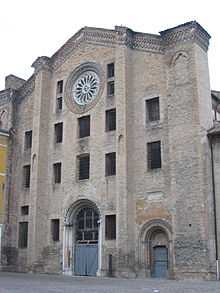
Churches
- Parma Cathedral: Romanesque church houses a 12th-century sculpture by Benedetto Antelami and a 16th-century fresco masterpiece by Antonio da Correggio.
- Baptistery: (construction began in 1196) by Antelami, stands adjacent to the cathedral.
- San Giovanni Evangelista: Abbey church originally constructed in the 10th century behind the Cathedral's apse, rebuilt in 1498 and 1510. It has a late Mannerist façade and a belltower designed by Simone Moschino. The cupola is frescoed with an influential masterpiece of the Renaissance: the Vision of St. John the Evangelist (1520–1522) by Correggio which heralded illustionistic perspective ceilings. Cloisters and library are also notable.
- Sanctuary of Santa Maria della Steccata.
- San Paolo, Parma: (11th century) Former Benedictine convent houses Correggio's frescoes in the Camera di San Paolo (1519–1520), and works by Alessandro Araldi.
- San Francesco del Prato: (13th century) Gothic church served as jail from Napoleonic era until 1990s, during which the 16 windows in the façade were opened. The Oratory of the Concezione houses frescoes by Michelangelo Anselmi and Francesco Rondani.
- Santa Croce: 12th century church in Romanesque style, had a nave and two aisles with a semicircular apse. Rebuilt in 1415 and again in 1635–1666. The frescoes in the nave by Giovanni Maria Conti, Francesco Reti and Antonio Lombardi) date to this period.
- San Sepolcro: church built in 1275 over a pre-existing religious edifice, interiors largely renovated in 1506, 1603 and finally 1701. The Baroque bell tower was built in 1616, bells completed in 1753. Adjacent is a former monastery (1493–1495) of the Regular Canons of the Lateran.
- Santa Maria del Quartiere (1604–1619) church characterized by an odd hexagonal plan; cupola is decorated with frescoes by Pier Antonio Bernabei and pupils.
- San Rocco: late-Baroque style church rebuilt in 1754 and dedicated to one of Parma's patron saints.
Palaces
- Palazzo della Pilotta (1583): It houses the Academy of Fine Arts with artists of the School of Parma, the Palatine Library, the National Gallery, the Archaeological Museum, the Bodoni Museum[6] and the Farnese Theatre.
- Ducal Palace, built from 1561 for Duke Ottavio Farnese on a design by Jacopo Barozzi da Vignola. Built on the former Sforza castle area, it was enlarged in the 17th–18th centuries. It includes the Palazzo Eucherio Sanvitale, with interesting decorations dating from the 16th centuries and attributed to Gianfrancesco d'Agrate, and a fresco by Parmigianino. Annexed is the Ducal Park also by Vignola. It was turned into a French-style garden in 1749.
- Palazzo del Comune, built in 1627.
- Palazzo del Governatore ("Governor's Palace"), dating from the 13th century.
- Bishop's Palace (1055).
- Ospedale Vecchio ("Old Hospital"), created in 1250 and later renovated in Renaissance times. It is now home to the State Archives and to the Communal Library.
Other
- The Teatro Farnese was constructed in 1618–1619 by Giovan Battista Aleotti, totally in wood. It was commissioned by Duke Ranuccio I for the visit of Cosimo I de' Medici.
- The Cittadella, a large fortress erected in the 16th century by order of Duke Alessandro Farnese, close to the old walls.
- The Pons Lapidis (also known as Roman Bridge or Theoderic's Bridge), a Roman structure in stone dating from Augustus reign.
- The Orto Botanico di Parma is a botanical garden maintained by the University of Parma.
- The Teatro Regio ("Royal Theatre"), built in 1821–1829 by Nicola Bettoli. It has a Neo-Classical façade and a porch with double window order. It is the city's opera house.
- The Auditorium Niccolò Paganini, designed by Renzo Piano.
- The Museum House of Arturo Toscanini, where the famous musician was born.
- Museo Lombardi. It exhibits a prestigious collection of art and historical items regarding Maria Luigia of Habsburg and her first husband Napoleon Bonaparte; important works and documents concerning the Duchy of Parma in the 18th and 19th centuries are also kept by the Museum.
Frazioni
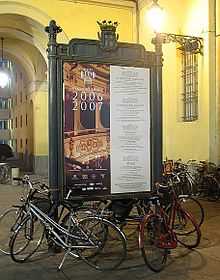
Alberi, Baganzola, Bedonia, Beneceto, Borgo Val di Taro, Botteghino, Ca'Terzi, Calestano, Carignano, Carpaneto, Cartiera, Casalbaroncolo, Casalora di Ravadese, Casaltone, Case Capelli, Case Cocconi, Case Crostolo, Case Nuove, Case Rosse, Case Vecchie, Casino dalla Rosa, Casagnola, Castelletto, Castelnovo, Cervara, Chiozzola, Coloreto, Corcagnano, Eia, Fontanini, Fontanellato, Gaione, Ghiaiata Nuova, Il Moro, La Catena, La Palazzina, Malandriano, Marano, Marore, Martorano, Molino di Malandriano, Osteria San Martino, Panocchia, Paradigna, Pedrignano, Pilastrello, Pizzolese, Ponte, Porporano, Pozzetto Piccolo, Quercioli, Ravadese, Ronco Pascolo, Rosa, San Pancrazio, San Prospero, San Ruffino, San Secondo, Sissa, Soragna, Tizzano Val Parma, Valera, Viarolo, Viazza, Vicofertile, Vicomero, Vigatto, Vigheffio, Vigolante.
Demographics
| ISTAT 2007 | ||
| Parma, Emilia-Romagna | Italy | |
| Median age | 46 years | 42 years |
| Under 18 years old | 14.9% | 18.1% |
| Over 65 years old | 22.9% | 20.0% |
| Foreign Population | 9.1% | 5.8% |
| Births/1,000 people | 8.53 b | 9.45 b |
In 2007, there were 177,069 people residing in Parma located in the province of Parma, Emilia-Romagna, of whom 47.4% were male and 52.6% were female. Minors (children ages 18 and younger) totalled 14.87% of the population compared to pensioners who numbered 22.90%. This compares with the Italian average of 18.06% (minors) and 19.94% (pensioners). The average age of a Parma resident is 46 compared to the Italian average of 42. In the five years between 2002 and 2007, the population of Parma experienced 6.97% growth, while Italy as a whole grew by 3.56%.[7][8] The current birth rate of Parma is 8.53 births per 1,000 inhabitants compared to the Italian average of 9.45 births.
As of 2006, 90.91% of the population was Italian. The largest foreign group came from other parts of Europe (namely Albania, Romania, and Ukraine): 3.61%, followed by Sub-Saharan Africa (namely Ghana): 1.86%, and North Africa: 1.44%. Approximately 17.9% of newborns has at least one parent of foreign origins, compared to the Italian average of 10.3%.[9]
| 2012 largest resident foreign-born groups[10] | |
|---|---|
| Country of birth | Population |
| | 3,981 |
| | 2,078 |
| | 2,035 |
| | 1,981 |
| | 942 |
| | 918 |
| | 899 |
| | 879 |
| | 829 |
| | 679 |
| | 589 |
Climate
In Parma, the average annual high temperature is 17 °C (63 °F), the annual low temperature is 9 °C (48 °F), and the annual precipitation is 777 millimetres (30.59 inches).
The following data come from the weather station located at the University in the city center, affected by the urban heat island phenomenon.
| Climate data for Parma (city center) | |||||||||||||
|---|---|---|---|---|---|---|---|---|---|---|---|---|---|
| Month | Jan | Feb | Mar | Apr | May | Jun | Jul | Aug | Sep | Oct | Nov | Dec | Year |
| Average high °C (°F) | 4.1 (39.4) |
7.5 (45.5) |
13.2 (55.8) |
18.0 (64.4) |
22.8 (73) |
27.3 (81.1) |
30.1 (86.2) |
29.3 (84.7) |
24.8 (76.6) |
17.8 (64) |
10.3 (50.5) |
5.4 (41.7) |
17.6 (63.7) |
| Daily mean °C (°F) | 1.3 (34.3) |
3.9 (39) |
8.9 (48) |
13.1 (55.6) |
17.6 (63.7) |
21.8 (71.2) |
24.4 (75.9) |
23.9 (75) |
19.9 (67.8) |
13.9 (57) |
7.6 (45.7) |
2.9 (37.2) |
13.3 (55.9) |
| Average low °C (°F) | −1.5 (29.3) |
0.4 (32.7) |
4.5 (40.1) |
8.3 (46.9) |
12.5 (54.5) |
16.3 (61.3) |
18.6 (65.5) |
18.2 (64.8) |
15.0 (59) |
10.1 (50.2) |
4.8 (40.6) |
0.4 (32.7) |
9.0 (48.2) |
| Average precipitation mm (inches) | 57 (2.24) |
55 (2.17) |
65 (2.56) |
76 (2.99) |
73 (2.87) |
56 (2.2) |
37 (1.46) |
48 (1.89) |
67 (2.64) |
96 (3.78) |
84 (3.31) |
73 (2.87) |
777 (30.59) |
| Source: Archivio climatico Enea-Casaccia (1961-1990)[11] | |||||||||||||
Food and cuisine
Parma is famous for its food and rich gastronomical tradition: Parmigiano Reggiano cheese (also produced in Reggio Emilia), Prosciutto di Parma (Parma ham). Parma claims several stuffed pasta dishes like "tortelli d'erbetta" and "anolini in brodo".
In 2004 Parma was appointed the seat of the European Food Safety Authority (EFSA). Parma also has two food multinationals, Barilla and Parmalat and a food tourism sector represented by Parma Golosa and Food Valley.
-
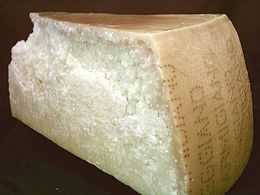
Parmigiano-Reggiano cheese, the true "parmesan"
-

Prosciutto di Parma (cured ham)
-

Tortelli d'erbetta
-

Anolini in brodo (broth)
International relations
Twin towns — Sister cities
Parma is twinned with:
|
Sport
Parma F.C., founded in 1913, is a Serie A football club renowned in Italy and Europe for its successes, including three national cups, a European Cup Winner's Cup, two UEFA Cups, a European Supercup and an Italian Supercup. It plays in the city's Stadio Ennio Tardini, which opened in 1923 and seats up to 23,000.
Parma's other prolific sport team is the rugby union club Zebre which competes in Pro12, one of the top rugby competitions in the world. Parma also is home to two rugby union teams in the top national division, Overmach Rugby Parma and SKG Gran Rugby.
Parma Panthers is the Parma American football team for which John Grisham's book Playing for Pizza was based.
Volleyball, women's basketball and baseball are also popular in the city.
Transport
Parma railway station is on the Milan–Bologna railway.
The Parma trolleybus system has been in operation since 1953. It replaced an earlier tramway network, and presently comprises four trolleybus routes.
Aeroporto Internazionale di Parma, Parma's airport, offers commercial flights to cities in a number of European countries.
Famous people

Painters and sculptors
- Francesco Mazzola, best known as Il Parmigianino, painter
- Alessandro Araldi, painter
- Michelangelo Anselmi, painter born in Tuscany
- Sisto Badalocchio, painter
- Giovanni Maria Francesco Rondani, painter
- Francesco Marmitta, painter
- Girolamo Mazzola Bedoli, painter
- Filippo Mazzola, painter
- Antonio da Correggio (Antonio Allegri), painter born in Correggio (Reggio Emilia)
- Benedetto Antelami
- Giacomo (or Jacopo) Zanguidi ( Bertoia)
- Giovan Federico Bonzagni
- Amedeo Bocchi
- Bartolomeo Schedoni
- Oreste Carpi
Others
- Giambattista Bodoni, typographer
- Amoretti Brothers, typographers and typefounders, Bodoni's opponents
- Ferdinando Paer, composer
- Giuseppe Verdi, opera composer
- Arturo Toscanini, conductor
- Fiorello Giraud, opera singer
- Bernardo Bertolucci, director
- Giovannino Guareschi, writer
- Vittorio Bottego, explorer
- Attilio Bertolucci, poet
- Alexander Farnese, Duke of Parma, military commander
- Cleofonte Campanini, conductor
- Vittorio Adorni, cyclist
- Adriano Malori, cyclist
- Alex Di Gregorio, cartoonist
- Vittorio Gallese, physiologist
See also
References
- ↑ http://www.dicasdesentupidoras.com/que-tipo-de-ar-condicionado-usar
- ↑ G. Drei, Le Carte degli archivi parmensi del secolo XII (Parma, 1950) doc. no. 194; the genesis of the Parmesan commune is studied by R. Schumann, "Authority and the commune: Parma, 833–1033", (Parma:Deputazione di storia patria, series 2.2, VIII) 1973.
- ↑ "Mapa da рrea de operaушes". Pitoresco.com. Retrieved 2009-05-06.
- ↑ "People power takes political control in Parma, Italy". bbc.co.uk. 2012-08-15. Retrieved 2012-08-16.
- ↑ 'Duomo Parma: La Città".
- ↑ "Bodoni Museum". briar press official website. briar press. Retrieved 2009-10-23.
- ↑ "Statistiche demografiche ISTAT". Demo.istat.it. Retrieved 2009-05-06.
- ↑ "Statistiche demografiche ISTAT". Demo.istat.it. Retrieved 2009-05-06.
- ↑ "Statistiche demografiche ISTAT". Demo.istat.it. Retrieved 2009-05-06.
- ↑ http://www.comuni-italiani.it/034/027/statistiche/stranieri.html
- ↑ "Archivio climatico Enea-Casaccia". Enea-Casaccia.
- ↑ "Medmestno in mednarodno sodelovanje". Mestna občina Ljubljana (Ljubljana City) (in Slovenian). Retrieved 2013-07-27.
Further reading
- Published in the 19th century
- "Parma", Hand-book for Travellers in Northern Italy (16th ed.), London: John Murray, 1897, OCLC 2231483
- Published in the 20th century
- Edward Hutton (1912), "Parma", The Cities of Lombardy, New York: Macmillan Co.
- "Parma", Northern Italy (14th ed.), Leipzig: Karl Baedeker, 1913
External links
- Parma's view from satellite (Google Earth)
- 360° photos of City of Parma
- Video Introduction to Parma and the Parmigiano Reggiano
- Video Brief History of Parma
- The European Food Safety Authority Website
- Photo Gallery by Leonardo Bellotti (Italian)
- Parma on The Campanile Project
